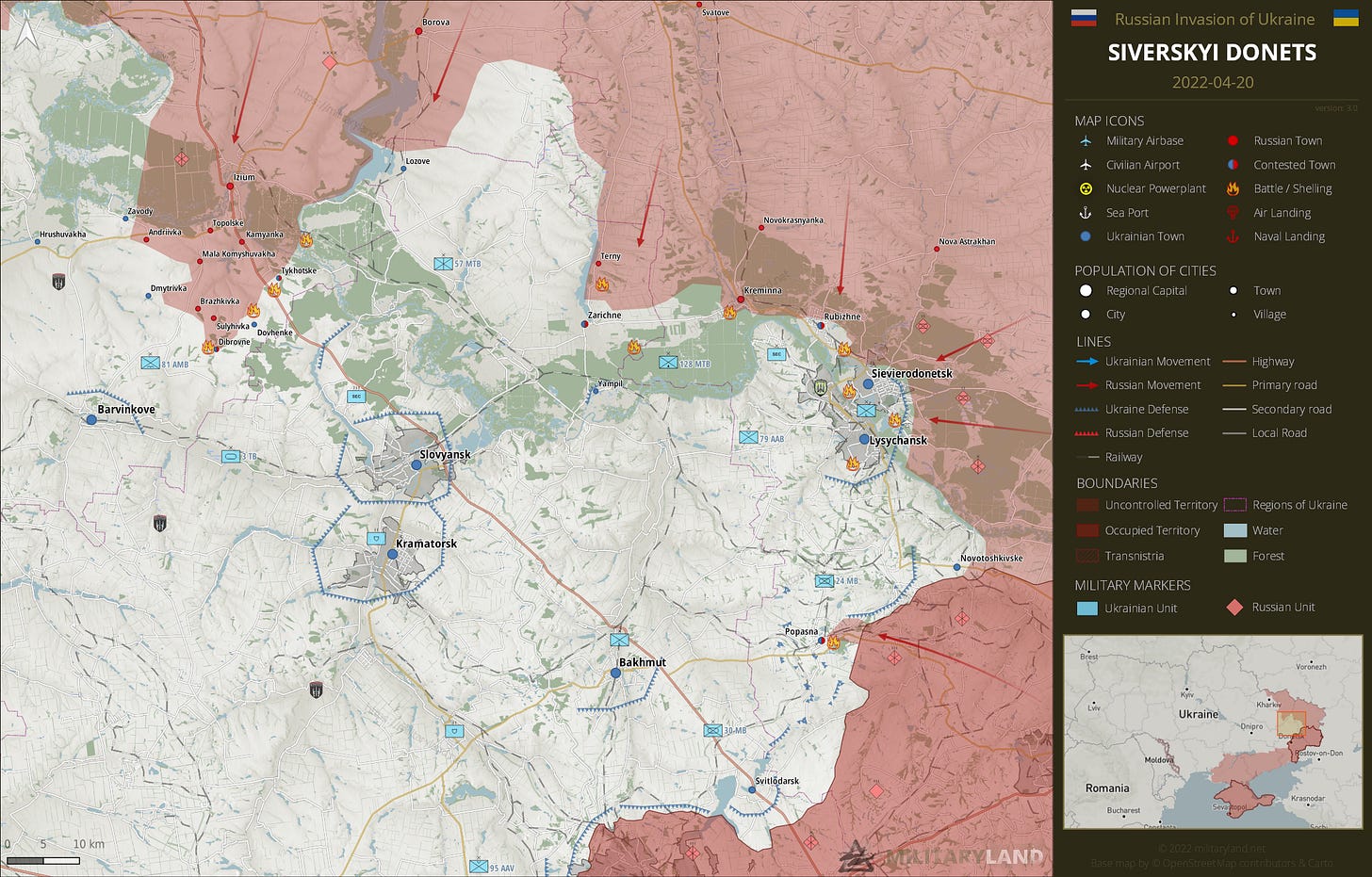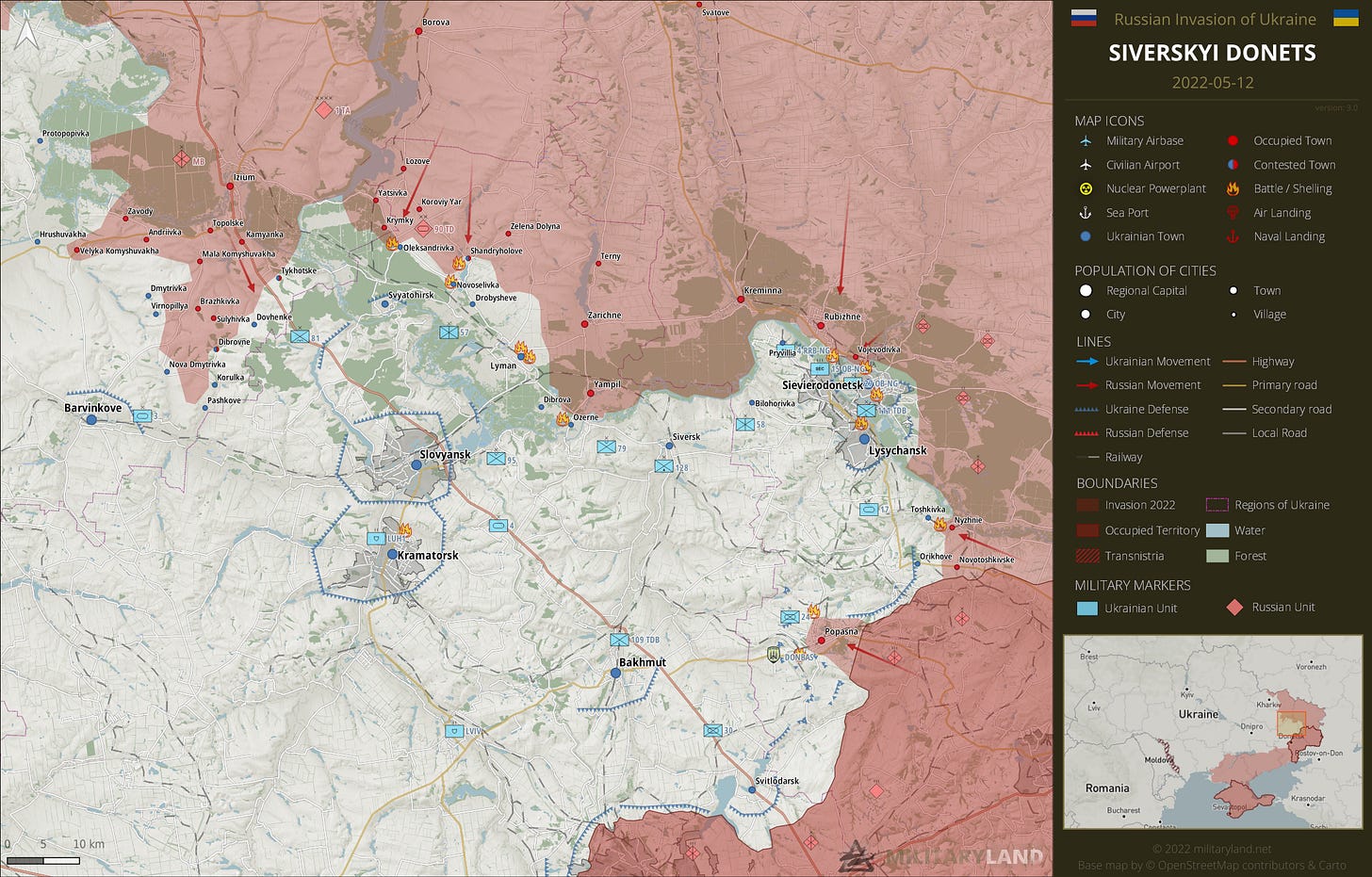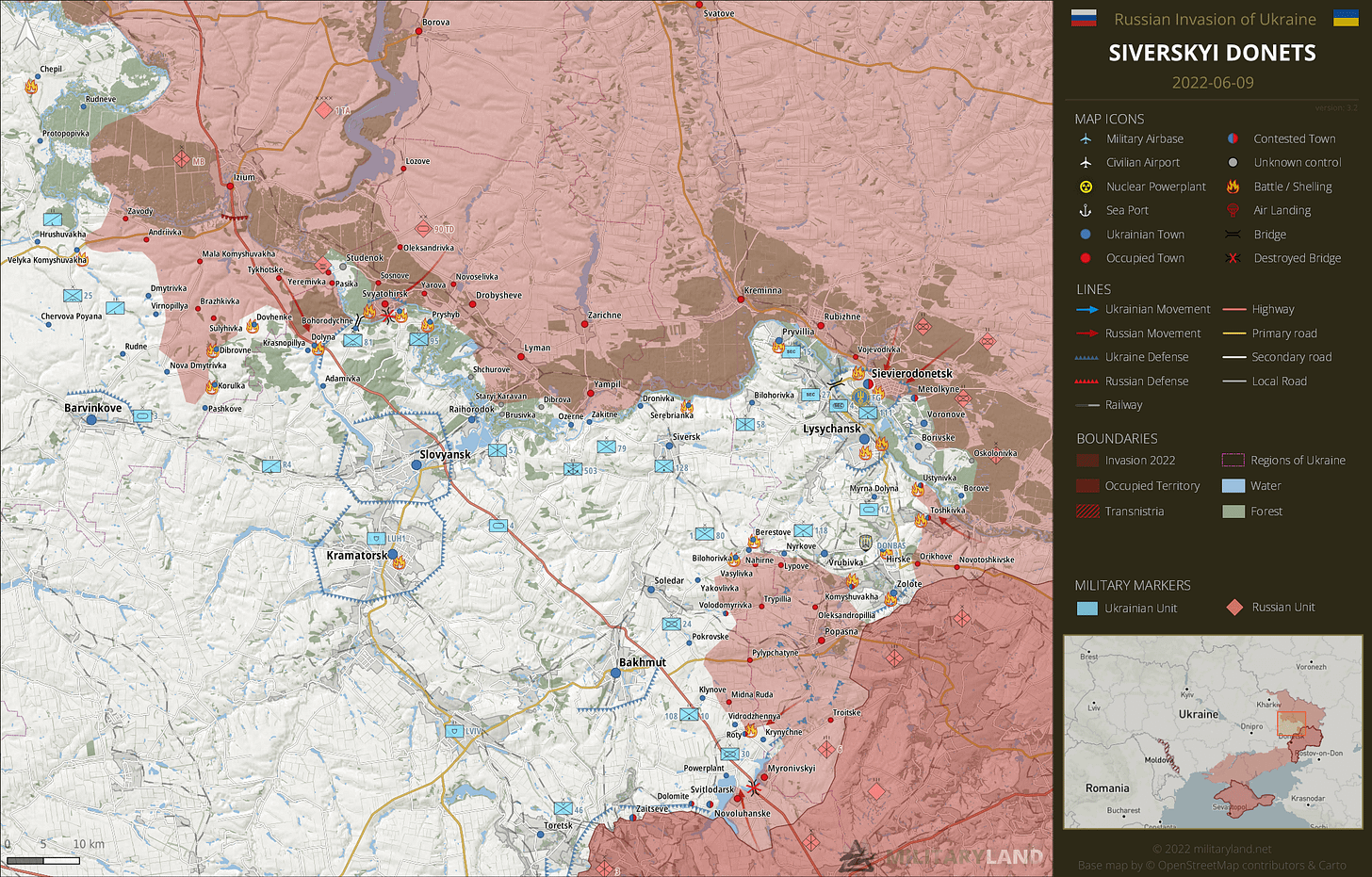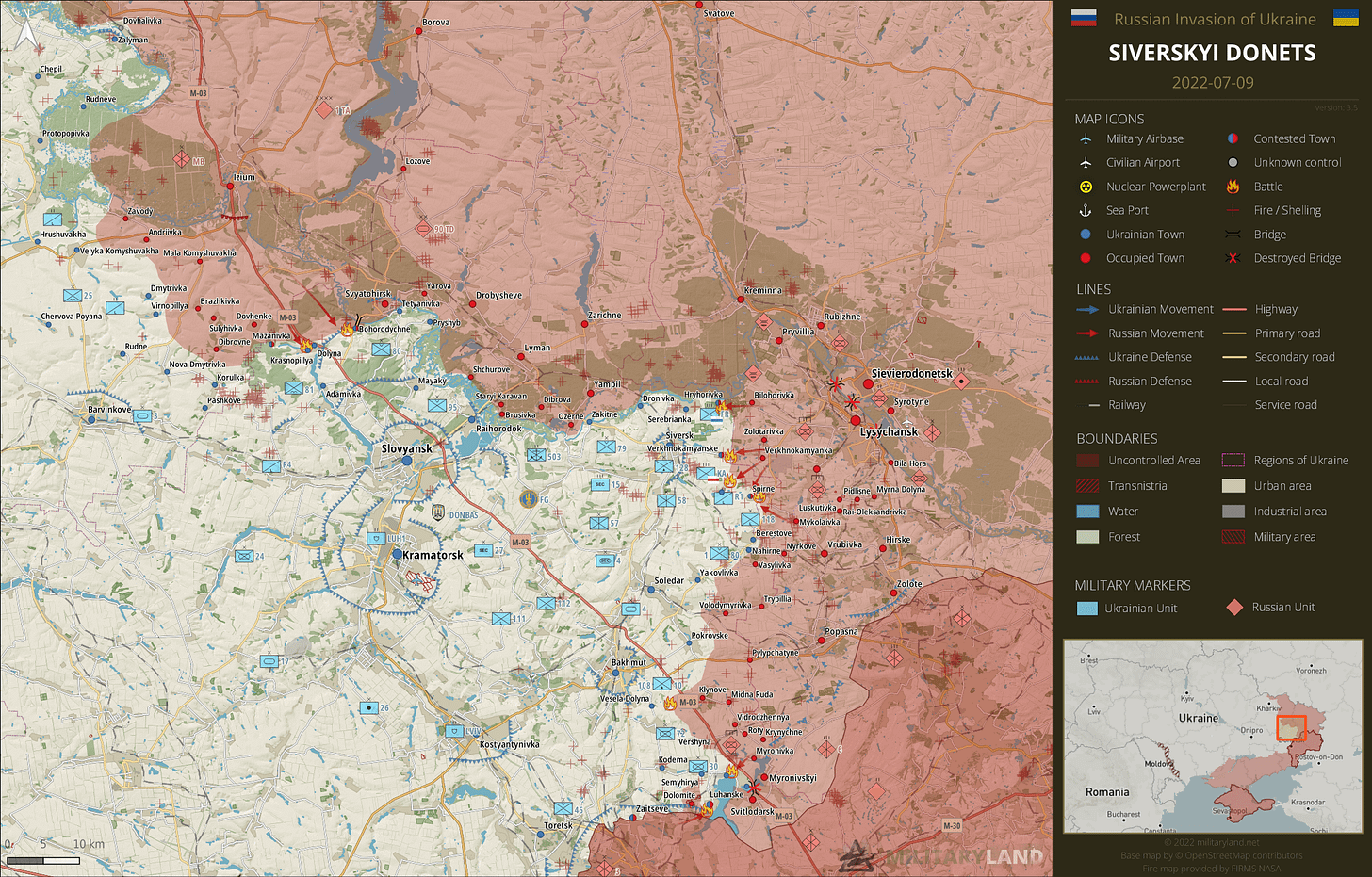To bring everyone up to speed, in Part 1 of this five-part series, I discussed the background and early rollout of the use of expendable troops in the Russo-Ukraine War, due to a systemic lack Russian dismounted infantry, with the solution being Ukrainian mobilized troops of the Luhansk and Donetsk People’s Republic of (L/DNR), who being barely trained but available in fairly large numbers, were deliberately used cheaply and recklessly as cannon fodder.
I will now discuss how the Russian private military company (PMC) Wagner Group took that concept and doubled down on it.
“Wagnerology”
I mentioned the Wagner Group in the previous article about their role in taking the key Donbas city of Popasna by way of professionally executed traditional dismounted infantry assault tactics, something the Russian Armed Forces had largely forgotten how to perform, and was largely unable to perform due to shortages in manpower. Why could Wagner do what the Russian Armed Forces couldn’t?
From what I have gathered, the Wagner Group was a PMC created circa 2014 from among Russian ex-military mercenaries who had already been serving as military contractors in Syria and then took up the fight in the Donbas War. Likely created with support by the top Russian leadership and the GRU (Russian Defense Intelligence), the Wagner Group was financed and led by a low-level Russian oligarch named Yevgeny Prigozhin, nicknamed “Putin’s Chef” for the empire he built on the foundation of a single hot dog stand in St Petersburg, turned fancy restaurant owner, turned defense logistics supplier courtesy of his favorite St Petersburg customer, one Vladimir Putin.
If Prigozhin was the CEO, CFO, and chief spokesman of Wagner, then the COO was undoubtably a man by the name of Dmitry Utkin, a former GRU Spetsnaz lieutenant colonel, a Russian Neo-Nazi with SS lightning bolt neck tattoos, whose radio call sign was Wagner, for whom the organization was named from.
Unlike US PMCs in Iraq and Afghanistan like Blackwater, Triple Canopy, DynCorps, Aegis, etc., the Wagner Group augmented security work with direct action offensive combat operations. For example, in Syria, they were being paid by the Assad regime to help retake key cities in exchange for cuts on oil export revenue. And in the Donbas in 2014-15, they were helping the Russian Separatists L/DNR forces, under contract with the Russian GRU. Due to the heavy ground combat they’d experienced in Syria and the Donbas War, Wagner had a large cadre of ex-Spetsnaz and VDV cadre who were highly motivated, well-paid, well-equipped, well-trained, whose specialty ended up being set-piece ground assaults, mounted or dismounted.
Wagner joined the Russo-Ukraine War shortly after it started, contributing a roughly brigade-sized force (2,000-3,000), with other Wagner units serving in various global conflict zones due to honor their contractual obligations. Wagner’s expeditionary combat force was organized, trained, and equipped to fight as a mechanized-dismounted combined arms force, styled on the table of organization and equipment of a Russian VDV brigade, including force multipliers like night vision, digital radios, battlefield tracker situational awareness computers and software, etc, the stuff typically only be found in VDV or Spetsnaz. (if you’re interested and want to know more, read this).
While Wagner was competent, capable, well-led, and elite in the very meaning of the word, they weren’t very big. But that was about to change.
Landing the Contract of a Lifetime
Before rolling into the story about Wagner Meat, it’s time for a quick history lesson so everyone understands the situation when these decisions were made. I’m going to do this quick and dirty with a few maps, courtesy of Militaryland.net
The operational situation in the Donbas in mid April 2022 saw the Russians attacking along a broad front all along Luhansk and Donetsk Oblasts (aka the Donbas) with supporting attacks in southern Ukraine, but predominately focused on breaching the the Siversky Donets River defensive line.
Then Popasna fell in early May and that collapsed the southern part of Ukraine’s defensive line.
The collapse of Popasna created a weak point in the AFU lines that the Russian exploited with follow on attacks, which broke through, outflanking the southern half of the AFU’s Siversky Donets River defensive line in June.
By early July, the Russians had managed to overrun nearly all of Luhansk Oblast when the Ukrainians were forced to retreat back to a new defensive line hinged on the high ground east of the Bakhmutka River Valley, home to the cities of Siversk and Bakhmut.
At that point the Russians had to take an operational pause moving their forces from the Siversky Donets defensive line to the Siversk-Bakhmut line. Taking the rest of Donetsk Oblast, Russia’s stated chief territorial strategic objective for their SMO, wouldn’t be easy. The next phase would necessitate frontally assaulting either the city of Siversk and/or Bakhmut, as they both lie in the direct route westward. After that, the Russians would need to cross the Bakhmutka River Valley, attack up and over a tall ridgeline to their west (which the city of Chasiv Yar sits atop), and only then being able to directly face the twin fortress cities of Sloviansk and Kramatorsk, the key administrative/military hubs of Donetsk Oblast. If those cities fall, the rest of the Donbas is really just a matter of mopping up. Thus, the upcoming assault on the Siversk-Bakhmut Line was a big deal.
So why did Wagner Group end up as the main effort assault force to take the main effort strategic objective of the Russian SMO?
My guess is that the overall weakness of the Russian Armed Forces led Putin and his Minister of Defense Shoigu to take drastic steps in the summer of 2022 to make their strategic goals possible without having to mobilize, and that meant empowering a paramilitary force that proved they could get things done. Which meant Prigozhin’s Wagner Group was awarded a contract and given their orders to take Bakhmut at the very least.
Based on the timeline I’ve been able to put together, Wagner must have gotten the go-ahead to prosecute the main effort assault to take Bakhmut around June 2022, potentially earlier. I say that because in July 2022 Yevgeny Prigozhin was already featured in international media conducting recruitment drives in Russian prisons looking for assault troops. And he wasn’t doing that to protect mines in Africa.
The Dirty Dozen Fifty Thousand
If I never saw the videos of Prigozhin’s bombastic speeches to the Russian prisoners myself I’d have laughed off the story as absurd propaganda. But even after watching them I was shocked. It was as if Prigozhin was channeling Lee Marvin’s character in the film The Dirty Dozen when recruiting the Army inmates for what amounted to a suicide mission. But with Prigozhin doubling down and going well beyond.
That crazy bastard gave a recruitment pitch telling those prisoners that he preferred murderers and violent offenders, that they’d be used as expendable troops, that if they disobeyed any orders they’d be summarily executed on the spot, etc. And it still worked!
In fact, so many Russian convicts ended up joining Wagner, they grew to corps size within months, supposedly swelling up to 50,000 in strength. To sweeten the deal, the convicts were offered lucrative incentives: For a six-month stint in the “Special Military Operation” (SMO) they would get a pardon, cash bonus, and the chance of a better future afterwards. Not a bad outcome for those stuck in that notoriously brutal Russian penal system for life.
Where did Prigozhin get the idea? While I’ll go into a bit more detail in the next Meat article about one more recent possibility, I think the most likely inspiration came from the Soviet Red Army’s use of Penal Battalions, the Shtrafbats, created by the infamous “Not a Step Back” Stalin Order No. 227 issued in the dark days of 1942. Those were made up of Red Army troops, enlistedmen and officers, who’d disobeyed orders, retreated without permission, or altogether pissed off their chain of command enough to not warrant a firing squad but still necessitating severe punishment. Penal Battalions were assigned to every field army and front to be attached to other units to do the dirtiest of dirty missions that an infantryman or combat engineer could be asked to perform. Their standard mission set were near-suicidal assaults, demining or laying mines in active “No Man’s Land”, and manning forward defensive positions against known German offensives to eat the preparatory artillery barrages and the leading assaults.
The Russian Bakhmut Campaign started around August 2022 and culminated in May 2023 when the city finally fell and Wagner was relieved by other units of the RUAF who took up a defensive footing. Wagner succeeded. But during their offensive, reports flowed in greater and greater numbers through the media, from Ukrainian troops, and even from within Wagner, about the brutal fashion in which Wagner was using their convict assault troops, using tactics, techniques, procedures, and regulations that copied much of the tactics, techniques, and procedures from the previous use of L/DNR Mobiks, with some added sadism.
Meat Waves?
Before I get into tactics, we need to address the elephant in the room: Was Wagner conducting Meat Waves, aka Human Wave Attacks at Bakhmut?
Well, what exactly is a Human Wave Attack? Or in the parlance of social media in recent years, what is a Meat Wave?
In all honesty, I’ve never found a suitable definition elsewhere so I created one myself based on the historical resources that seriously described them: A Human Wave Attack is a derogatory term for a post WW1 dismounted infantry attack using rudimentary infantry tactics, relying on mass as a combat multiplier, emphasizing close combat, conducted at the walk or run with little to no fire and movement, with little to no supporting fires, performed in a skirmish line formation with follow on forces in echelon (waves), with subsequent waves attacking regardless of lack of success or casualties of the previous waves, and with little or no changes in tactics between waves.
Point of order. No military force thinks it conducts Human Wave Attacks, they definitely don’t include the term in their doctrine. I think they’re typically caused either by errors from faulty doctrine, the result of poor intelligence on the enemy situation, faulty planning, a breakdown in coordination, and nearly always coupled with pressure from superiors to subordinates to aggressively attack and get results, whatever the cost. And for added flavor, toss in a pinch of stubbornness and callousness by commanders to sustain those heavy losses to appease their bosses.
I do think Human Wave Attacks have happened regularly in the past, most notably the Red Army in WW2 (in 1941 especially), the Imperial Japanese Army throughout WW2, the Republic of Chinese KMT, the PRC Chinese PLA, the Vietnamese especially against the French in the Indo-China War, and the Iranians in the Iran-Iraq War, specifically the Basij Militia.
With that out of the way, was Wagner also conducting Human Wave Attacks, aka Meat Waves, during the Bakhmut campaign?
Almost, but No.
How Wagner convict assault units conducted their missions nearly fits my definition of Human Wave Attacks (and others too), but I don’t think the Wagner attacks had the mass necessary to fit the definition properly. Attacks done in what amounts to reinforced fireteams or squads in staggered column formations, not in line formation, with waves often separated by hours or days, are hardly the massed waves of humans described in the past when entire companies or larger were attacking together, with repeated waves of similar size formations coming over and over in short periods, where in the matter of hours, the dead would literally be stacked multiple feet high atop each other.
So if Wagner wasn’t doing Human Wave Attacks in Bakhmut, what were they doing that could be so easily and often confused with them?
Wagner Infantry Tactics, Techniques, and Procedures
Reports suggest that Wagner was utilizing mixed assault groups, with the actual assault element meant to conduct the attacks, covered by fire support elements (machine gun, automatic grenade launchers, mortars, snipers, anti-tank guided missiles), security elements to hold their flanks, consolidation elements to dig in and hold ground after it was taken, also with command, recon, electronic warfare, and drone elements to round them out.
Wagner convict Meat seemed to be organized in three man teams (troika), in squad-sized formation of two to three teams. Despite their expendable nature, they were still heavily armed with rifles, GPMGs, and shoulder-fired rocket launchers, mostly RPGs and RPO-A thermobaric types. Each team member was also given a cell phone without SIM card to use for land navigation purposes only, utilizing the GPS function, with preset maps uploaded of their area of operation, with known enemy positions, routes, checkpoints, and other control features preloaded. Each team member also supposedly carried a cheap, unsecure ICOM-type FM radio, the type you can typically find on Amazon for $30, to communicate with one another and with their leadership.
Leadership on the ground was either a professional Wagner mercenary or a picked convict given more responsibility, serving as the equivalent of a squad leader. Actual command and control for these missions seems to have been done by Wagner leaders in the rear, watching the live drone feed from an accompanying ISR recon drone, giving commands as necessary to those on the ground through their ICOM radios.
What were the ultra-dangerous infantry missions that Wagner convicts were typically performing?
Reconnaissance-in-Force: Because AFU defensive outposts and strongpoints were heavily dispersed, often well camouflaged, using dummy positions, and doing their best to remain undetected, despite the Russians possessing rather good reconnaissance drone coverage of the forward line of enemy troops, it was still difficult for the Russians to know where defenses were located. And that’s a big problem when it comes to planning attacks. Without knowing exactly where the defenses are located, how they are situated, their readiness, weaponry, fields of fire, obstacles, etc, a deliberate attack has little chance of succeeding, at least without heavy losses.
Like the L/DNR Mobiks before them, Wagner used their convict Meat assault groups to to find those AFU defensive positions by reconnaissance-in-force attacks, whereby Wagner convicts were given the location of likely or suspected enemy positions during mission planning, told to advance against them, and then finding them by effectively stumbling into the defensive and being fired on by defenders.
Placed in a similar situation, a trained recon unit could probably break contact at that point without heavy losses, if any. In fact, a good recon team can find the enemy without the enemy knowing they’re being observed. But poorly trained convicts cannot do that, making that a very dangerous mission for them, with a high likelihood of becoming casualties to small arms fire, not to mention the added threat of being caught in the open by enemy drones or forward observers and having fires called on them. To make matters worse, Wagner convicts weren’t allowed to break contact after being discovered, their commanders wanted them to remain in contact with Ukrainians defenders to develop the situation, find flanks, attempt assaults.
This was all bad news for the Wagner Meat assault groups on the ground, but great news for the Wagner assault detachment command elements in the rear, watching the ISR drone feeds, discovering the newly identified AFU defensive positions firing on their men. Those types of missions would provide some top-quality intelligence. Obviously they’d learn the defensive position locations, but also the general size and shape, the number of troops defending it and their protective posture, their potential sectors of fires, potential blind spots, nearby defilade/dead space, obstacles, and all sorts of other valuable info that would be used for planning future attacks, with those having a much higher likelihood of success than the probing attacks, courtesy of Meat.
With better intelligence on the enemy situation, follow-on assault elements would usually be performed by the better trained, led, organized, and equipped elite Wagner assault groups, primarily operating at night using thermals and night vision optics, which were quite useful since most AFU infantrymen didn’t possess them.
Deliberate Attacks: If specific AFU defensive positions were located, and if it was believed they were weakly held, Meat assault groups would probably succeed in taking them. Might as well try anyway. If they succeed, great! If they don’t, the failed attempt by Meat would still provide useful intelligence to the command element of the assault detachments, increasing odds that their next effort would succeed. Either way, win win.
Attrition: Once an AFU defensive position was identified, it would not only be hit by fires but by likely be hit by repeated Meat assaults. The Ukrainian defenders would take casualties, they’d be forced to consume excess ammo, they’d become mentally/physically exhausted, and that would trigger a need for them to be rotated out and relieved in place by another unit of defenders. During which they would be ripe for being hit by fires or for a deliberate assault.
The added benefits of repeated Wagner Meat assaults was that it didn’t just force AFU front line infantrymen to fire, but also revealed the positions of AFU supporting fires too, which could be tracked and engaged by Russian counterbattery fires.
Infiltration: By order, the convict assault groups were required to advance forward. If they were unlucky, they ran right into a Ukrainian position and got shot at. If they were lucky, without stumbling on a land mine or running into small arms fire from a defending position or being caught by the recon drone screen, they might discover a gap between AFU defenses, allowing the Meat assault groups to bypass strongpoints and outposts and move deeper into the Ukrainian tactical rear, outflank and assault the AFU defensive positions from a vulnerable flank or rear, or to cut the AFU defender’s lines of retreat/resupply.
“The Beatings Will Continue Until Morale Improves”
With their day-to-day missions having such a high risk of death or serious bodily harm, how did Wagner keep chronically delinquent, violent convicts under firm discipline?
They did it with brutal punishments, the type that would have made a WW2 NKVD executioner a bit queasy.
If Wagner convict troops retreated without permission, they were supposed to be immediately summarily executed. If they refused to advance, summarily executed. Self-evacuate due to wounds without permission, summarily executed. Deviate from the pre-planned route without permission, summarily executed. If they violated an order of any kind in the rear, their Wagner superiors would literally beat them to death with sledgehammers.
And yet despite the unbelievably brutal discipline imposed by Wagner professionals on their Meat personnel, it didn’t hurt convict recruitment effort at all. More so, it got the job done. And that can’t be said enough. Despite the extremely stubborn AFU defense, with the added media rallying cry of “Bakhmut Holds!” But it didn’t hold, Wagner and its convict assault groups won in the end.
Many try to justify or describe the Bakhmut Campaign this way or that, but I think the best description is of a meat grinder battle where the cream of the AFU was wasted away trying to maintain a beneficial kill ratio against Wagner convict Meat. But a 3:1 ratio of Russian dead to Ukrainian wasn’t going to cut it. Even at a 5:1 ratio, even at a 50:1 ratio, it didn’t matter. The Russians could afford to lose expendable convicts far more than the Ukrainians could afford to lose the core of their mobilized, motivated army. Attritional warfare is cheaper using cannon fodder.
Once again, Meat worked.
Stay tuned for the Meat Part 3, “Plagiarism is the Sincerest Form of Flattery.”






Just wanted to say I've been a long time follower of you on Reddit whenever you have contributions on the likes of r/WarCollege. It's fantastic to see you start a substack where you can convey your thoughts and information in a more structure format that's more on your terms. I've been reading your posts in order and been enjoying all of them. I suspect your NGSW article will trigger my keyboard fingers (due to vehement agreement).
An excellent write-up on the Wagner convict troops.